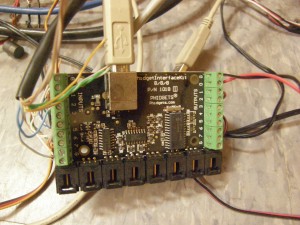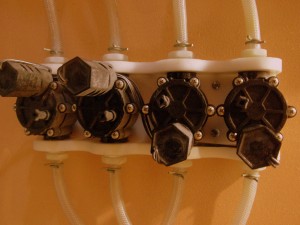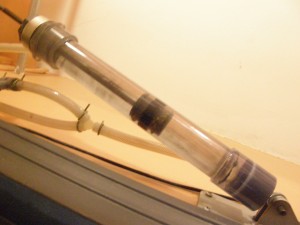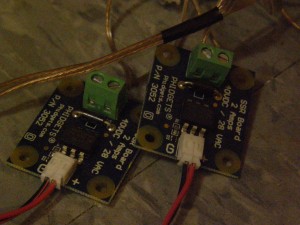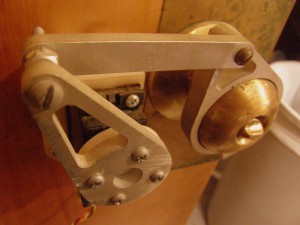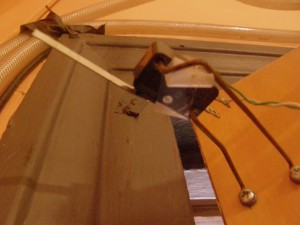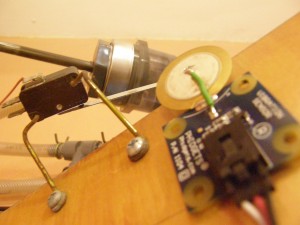iDoor – iPhone Controlled Hydraulic Door
Opening up the door to your dorm room?
There’s an app for that.
Here’s the story of iDoor, the iPhone controlled hydraulic dorm room door. Enjoy. Credits to Greg Schroll for most of the hardware.
Life at MIT can be tough. With all the problem sets, and projects taking up time, when I come back to my dorm room to crash, I don’t want to waste time opening doors myself! That’s why my room is outfitted with an iPhone controlled hydraulic door opener and unlocker. Just tap the “iDoor” app on my phone’s home screen, and the door opens for me. Its 2009 after all, about time we stopped carrying around shaped bits of metal to open up locked doors.
Chris Varenhort’s iPhone has one special app…
When security isn’t my chief concern, I can even ditch the phone altogether and just give iDoor a ‘secret’ knock (not so secret any more) and let the vibration sensor trigger the door opening. See the video above for the full run through.
Technical Overview
iDoor is controlled directly from a scrounged up PIII computer running Ubuntu, interfaced with the hardware using the wonderful Phidget 8/8/8 control board. An early version of the controls used an MIT Happyboard, but for Internet connectivity and development speed, the full PC was chosen. The software was written in Java using the Phidget library. (I’ll share the code if you’re interested).
The door is opened by a hydraulic actuator that taps into the sink in the room. It was built by Greg Schroll in 2006. The sink inflow tap and outflow tap are connected to a set of 4 one-way solenoid valves. These valves are connected in such a way that together they can function as a 3-way valve. Either pushing water one way in the chamber, forcing the piston to open the door, pushing it the other way, forcing the piston to close the door, or diverting water directly from the sink tap to the sink drain (just wasting water!). The door actuator was custom built by Greg, so get it touch with him if you have questions about its construction.
There are two relays between two pairs of solenoids and the 24v power supply. The relays are tripped from the control board. One relay opens the door, the other closes it.
To ‘unlock’ iDoor, a Phidget servo controller has a large Hitech HS-755 servo twist the handle. While opening, it just twists the handle all the way, and when closing, the pulse width is enough to keep the deadlatch from applying too much friction to the strike plate, but still lock. The servo controller can’t output enough power to turn the big servo, so I spliced in a 1.5A 5v cell phone power supply.
There are two limit switches on the door that depress when the door is in its fully closed or fully open state. The software uses these to know when to close the solenoids.
Interfaces
There’s a re-appropriated handicap button(seen in video) that also ties into the Phidget control board for easy opening when I’m away from my computer or without my phone. It also functions as an emergency stop button to stop the door while it’s moving.
For knock activation, there is a vibration sensor at the top of the door positioned so that when the door is closed the sensor part touches the doorframe. The control software uses the analog input from this sensor to detect my secret knock pattern, and open the door.
I also had my laptop configured so a particular key combination would alternate the door’s state.
A nice property of the whole design is that it can be completely removed from the room without too much work (though who would want too?).
Thoughts of living with it for 9 months…
I spent my senior year living with this door, and besides having to replace a servo, it pretty much worked flawlessy. The only trouble was my hallmates hacking the door, and random EM noises doing weird things to it. I’m not sure if I’ve actually saved time in the long run, but it was definitely fun. Some of my favorite uses of the door are opening it remotely for friends that need to get stuff out of my room, (though it can be confusing for people that aren’t familiar with it). If I leave in a hurry, I can also just tell my phone to close my door when I remember later. Another good trick is opening and closing the door randomly during parties on my hall, confusing bystanders endlessly.
Some things I’ve discovered:
- When I turn on my speakers, my door handle twitches.
- Once I left a long analog input cable going into the control board, and it would somehow pick up noise in just the right pattern to trigger the opening sequence. This always happens at about 4am while I am sleeping.
- A secret knock, isn’t actually that secure.
- Handicap buttons aren’t as hard to find as you think
- Even after 9 months, it never gets old.
